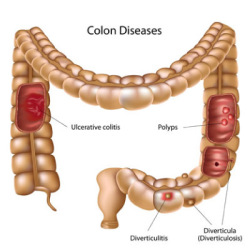To understand diverticulosis, it is helpful to know about the anatomy and function of the intestine. The small intestine is the long, thin segment of bowel that begins at the stomach and ends at the large intestine or colon. The colon starts in the right lower abdomen and forms a large question mark across the entire abdomen ending in the rectum. Just above the rectum is the sigmoid (S-shaped) part of the colon. Liquid stool enters the right colon and, as it moves through the colon, is dehydrated so that a formed stool eventually enters the rectum.
The Sigmoid Colon
The sigmoid colon has the specialized job of contracting vigorously to maintain a high pressure. This action regulates the movement of stool into the rectum. And since the sigmoid is a high-pressure part of the colon, it is here that most diverticula occur.
Diverticulosis
Diverticulosis means that there are pockets or projections extending out from the colon wall. These occur very gradually over a long period of time. They occur along the natural weak points in the bowel wall.
The pockets develop because of the pressure exerted within by the contracting colon. As noted earlier, since the sigmoid colon has the highest pressure in the colon, it is here that most diverticula occur. Because of these bubble-like projections, the sigmoid often becomes thickened and narrowed. When this happens, significant changes in the bowel function can occur, such as discomfort, cramps, diarrhea, and/or constipation.
Who Gets Diverticulosis?
Since it takes so long to develop, diverticulosis usually appears later in life. However, it is not uncommon to see this occur in people who are in their 30s. Eventually the colon, especially the sigmoid colon, becomes studded with these pockets. The disorder is mostly one of Western society. It is uncommon in rural Africa and India. The diet in these areas consists of higher amounts of unprocessed foods and grains with a very high fiber content. So, increased fiber ingestion may have great benefit.
Symptoms of Diverticulosis
As diverticula form, few symptoms are noticeable, except perhaps for intermittent spastic discomfort in the left lower abdomen. Usually, there are no symptoms at all.
When diverticulosis is far advanced, the lower colon may become very fixed, distorted, and even narrowed. When this occurs, there may be thin or pellet-shaped stools, constipation, and an occasional rush of diarrhea. The problem then becomes a mechanical or structural one, and treatment is more difficult.
Complications of Diverticulosis
It is, perhaps, remarkable that so few people have complications of diverticulosis when compared with the number of people who have the condition. Still, complications do occur and they can be serious. Diverticulitis is the most common.
- Diverticulitis: Like a balloon, as a diverticulum expands, it develops a thin wall compared with the rest of the colon. The colon is home to many beneficial bacteria — helpful as long as they stay in the colon. However, these bacteria can seep through the thin wall of diverticula and cause infection. This infection around diverticula is called diverticulitis. It can be mild with only slight discomfort in the left lower abdomen. Or it can be quite extreme with severe tenderness and fever. Treatment is usually needed for diverticulitis. Some mild cases of diverticulitis can be treated with bowel rest and time. When a more serious infection is present, antibiotics are prescribed. For severe cases, the patient must be hospitalized.
- Bleeding: At times, bleeding can occur from a ruptured blood vessel in diverticula. This may produce a gush of blood from the rectum or, occasionally, darker, mahogany color stools when the bleeding is from a diverticulum in the upstream, right colon.
- Perforation: This complication of diverticulosis is the most uncommon but the most serious. It may follow severe diverticulitis. Bacteria escape into the abdomen where peritonitis, or an abscess, can develop. Abdominal surgery or drainage of the infection usually is required to correct this problem.
Summary
Diverticulosis is a disorder that may be preventable if treated early in life. At any stage, there is usually effective therapy available. Diverticulitis, a complication of diverticulosis, can be readily diagnosed by the physician and effective therapy is available. Working with the physician, prevention and treatment programs can be structured to obtain the best results for the patient.
